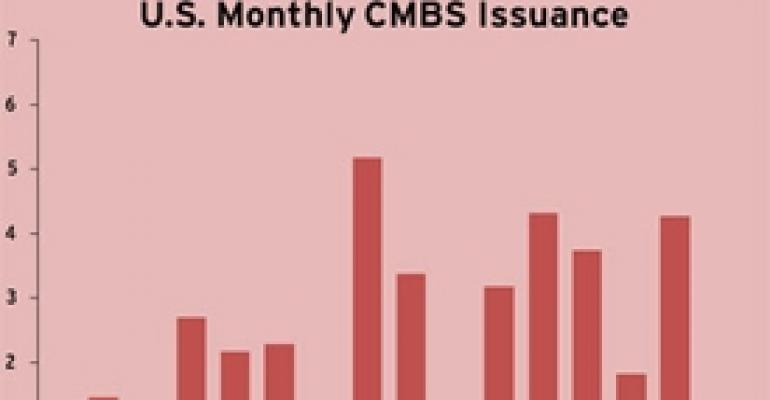Recent events have proved once again that even the best laid plans of real estate lenders often go awry.
As the commercial real estate market stabilized in 2010 and conduit lenders began to feel more comfortable with property fundamentals, many industry insiders predicted CMBS issuance would spike to $40 billion or $50 billion this year.
But with the European debt crisis, the possibility of a double-dip recession in the U.S., the cancellation of a Citigroup/Goldman Sachs securitization in August and admissions from Standard & Poor’s that it had “potentially conflicting methods” in how it was rating securitizations, bond buyers have been spooked in recent months. As a result, CMBS issuance in 2011 might well come in under $30 billion, according to Manus Clancy, senior managing director with Trepp LLC, a New York City-based provider of CMBS and commercial mortgage information. The figure would be far ahead of the $11.7 billion in issuance completed last year, but still nowhere near the peak year of 2007 when originators cranked out $230 billion in loans.

Year-to-date, conduit lenders closed $26 billion in new issuance, including $4.3 billion in September, according to Commercial Mortgage Alert, an industry newsletter. There might be a few more issues in the works, but don’t expect a huge spike in volume. Based on recent indications from issuers, overall CMBS volume could potentially rise by another $3 billion by the end of the year, according to Ken Cheng, managing director of CMBS new issue with the Structured Credit Ratings business of Morningstar.
“I think there are a lot of issues going on and they are each weighing on the CMBS market,” says Clancy, citing fears of a double dip and the growing concern that prices on trophy commercial buildings are now too high. “The spread volatility has made lenders very, very skittish. At the end of 2010, they had kind of a predictable spread level they could [work with]. Now they are not sure how to price those loans.”
As of October 6, spreads to Treasuries on 10-year fixed-rate triple A conduit loans stood at 339 basis points, according to Commercial Mortgage Alert. The figure was more than a percentage point higher than the 52-week average of 218 basis points. Spreads on 10-year fixed-rate triple B notes were at 4,543 basis points, up from a 52-week average of 3,890 basis points.
Higher spreads wouldn’t be such an issue if market insiders knew they would stay at the current level for some time, Clancy says. But many are worried spreads might climb higher and higher in coming weeks and months.
“There are some storm clouds on the horizon—swap rates have gone up in the last week or so. One more scare from either the Euro or the stock market taking a dive and B-note buyers will pull back again and that will have an effect on the overall market,” says Dan E. Gorczycki, managing director in the New York City office of Savills LLC, a real estate services provider.
The good news
Luckily, conduit lenders continue to lend, even if it’s not at the level many had hoped for.
KeyBank Real Estate Capital Markets, for example, expected to close $1 billion in CMBS issuance in 2011, but will likely end the year with $300 million to $400 million, according to Clay Sublett, senior vice president of loan origination with the firm. Part of the reason for this has been lower than expected demand, but the low issuance has also been a function of the difficulty of pricing loans in the absence of good guidance.

“There is not enough bonds clearing the market to provide clear direction on the price,” says Sublett. “And when it becomes difficult to price people price wider as a safeguard and it becomes more difficult to compete against alternative financing deals.”
The hitch is that there has been minimal loosening of terms over the past 12 months, as perilous market conditions have forced Wall Street firms to be less aggressive than they would be otherwise.
Multifamily, office and retail properties still get preference because of their long term leases. While CMBS lenders will pick up some hotels, they try to limit hotels’ portion of any given CMBS pool to under 15 percent because of the sector’s particular vulnerability to shifting economic conditions, says Gorczycki.
What’s more, CMBS issues are still made up largely of core assets in primary markets or buildings with low leverage in secondary markets with good fundamentals, says Clancy.
“The CMBS market never evolved to the point where you could get smaller loans in secondary or tertiary cities for unusual property types,” he notes. “Lenders were not ready to make that market over the last 12 months, and now they are really not ready to make that market.”
Debt yields have also come into sharp focus lately, with a minimum expected debt yield of 10.5 percent, according to Sublett.
Through most of the year, loan to value (LTV) ratios on CMBS loans have typically fallen between 70 and 75 percent, according to Cheng. A recently closed five-year CMBS loan on an office property, for example, featured a 6.03 percent fixed interest rate, 70 percent LTV and a 30-year amortization schedule, according to a September report from Cushman & Wakefield Sonnenblick Goldman, a New York City-based real estate financial services firm.
Looking at recent issues, however, weighted average LTV ratios have been more conservative at about 60 percent, Clancy says. Weighted average interest rates have been hovering around 5.5 percent, largely as a result of low Treasury rates on 10-year notes, which in September stood at 1.93 percent.
Unless the general economic outlook begins to improve or Washington comes up with a viable reform plan, the CMBS market will continue to muddle along, he warns.

